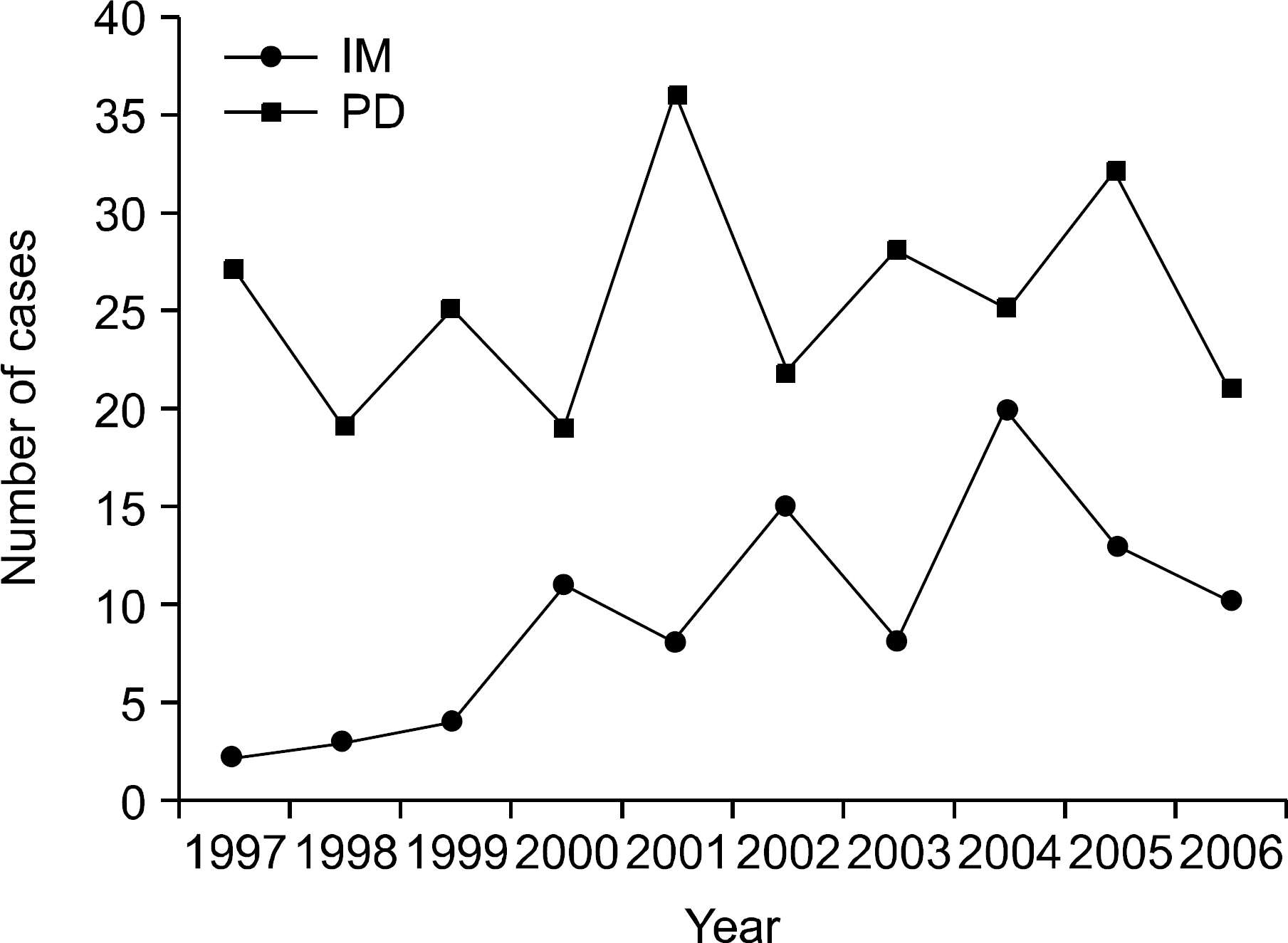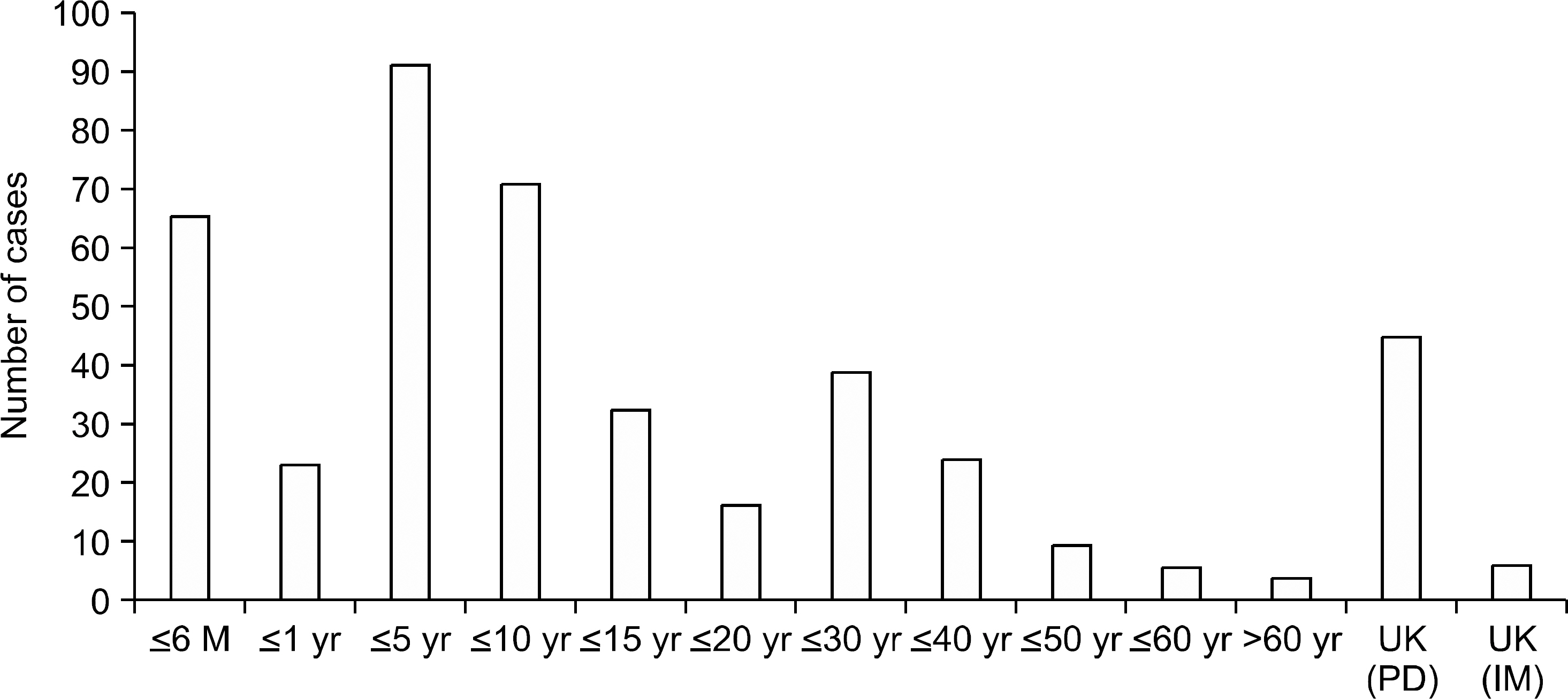Hereditary Hemolytic Anemia in Korea: a Retrospective Study from 1997 to 2006
- Affiliations
-
- 1College of Medicine, Yeungnam University, Korea. johah@med.yu.ac.kr
- 2The Catholic University of Korea, Korea.
- 3Kyungpook National University, Korea.
- 4Gyeongsang National University, Korea.
- 5Korea University, Korea.
- 6Keimyung University, Korea.
- 7Daegu Catholic University, Korea.
- 8Pusan National University, Korea.
- 9Seoul National University, Korea.
- 10Sungkyunkwan University, Korea.
- 11Ajou University, Korea.
- 12Yonsei University, Korea.
- 13Ulsan University, Korea.
- 14Eulji University, Korea.
- 15Ewha Women's University, Korea.
- 16Inje University, Korea.
- 17Inha University, Korea.
- 18Chonnam National University, Korea.
- 19Chonbuk National University, Korea.
- 20Chungnam National University, Korea.
- 21Chungbuk National University, Korea.
- 22Pochon CHA University, Korea.
- 23Hanyang University, Korea.
- 24National Cancer Center, Korea.
- 25National Medical Center, Korea.
- 26Daegu Fatima Hospital, Korea.
- 27Seoul National University Bundang Hospital, Korea.
- KMID: 2305194
- DOI: http://doi.org/10.5045/kjh.2007.42.3.197
Abstract
-
BACKGROUND: The aim of this study was to investigate the prevalence, clinical and laboratory findings of hereditary hemolytic anemia (HHA) in Korea from 1997 to 2006 and to develop the appropriate diagnostic approach for HHA.
METHODS
By the use of questionnaires, information on the clinical and laboratory findings ofHHA diagnosed from 1997 to 2006 in Korea was collected and analyzed retrospectively. A total of 431 cases were enrolled in this study from 46 departments of 35 hospitals.
RESULTS
The overall frequency of HHA did not change through the 10-year period for pediatrics but did show an increasing tendency for internal medicine. The overall male to female sex ratio did not show sex predominance (1.17:1), but a significant male predominance with a ratio of 1.49:1 was seen for pediatrics while a significant female predominance with a ratio of 1:1.97 was seen forinternal medicine. Of the total cases, 74.2% (282/431) were diagnosed before the age of 15 years. The etiologies of HHA were classified as red cell membrane defects, hemoglobinopathies, red cell enzyme deficiencies and unknown causes. There were 382 cases (88.6%) of red cell membrane defects with 376 cases (87.2%) of hereditary spherocytosis and 6 cases (1.4%) of hereditary elliptocytosis, 20 cases (4.6%) of hemoglobinopathies with 18 cases (4.2%) of beta-thalassemia, a case (0.2%) of alpha-thalassemia and a case (0.2%) of Hemoglobin Madrid, 7 cases (1.6%) of red cell enzyme deficiencies with 5 cases (1.2%) of glucose-6- phosphate dehydrogenase (G-6-PD) deficiency, a case (0.2%) of pyruvate kinase (PK) deficiency and a case (0.2%) of enolase deficiency, and 22 cases (5.1%) of unknown causes. The most common chief complaint in pediatric patients was pallor and that in adult patients was jaundice. In the red cell membrane defect group of patients, the level of hemoglobin was significantly higher than in adult patients. The mean corpuscular volume, mean corpuscular hemoglobin, corrected reticulocyte count, total and indirect bilirubin level and lactate dehydrogenase levels in the hemoglobinopathy group of patients were significantly lower than the values in the red cell membrane defect group of patients. The mean concentration of G-6-PD was 0.8+/-0.7U/1012RBC in the G-6-PD deficient patients, PK was 1.7U/1010 RBC in the PK deficient patient, and the level of enolase was 0.04U/g of Hb in the enolase deficient patient.
CONCLUSION
The most prevalent cause of HHA in Korea during 1997 to 2006 was hereditary spherocytosis, but HHA by other causes such as hemoglobinopathy and red cell enzyme deficiency gradually increased with the development of molecular diagnostic methods and increasing general interest. However, the etiologies of HHA need to be pursued further in 5.1% of the patients. An systematic standard diagnostic approach is needed in a nationwide prospective study for correct diagnoses and appropriate management of HHA.
Keyword
MeSH Terms
-
Adult
alpha-Thalassemia
Anemia, Hemolytic, Congenital*
beta-Thalassemia
Bilirubin
Cell Membrane
Diagnosis
Elliptocytosis, Hereditary
Erythrocyte Indices
Female
Hemoglobinopathies
Humans
Internal Medicine
Jaundice
Korea*
L-Lactate Dehydrogenase
Male
Oxidoreductases
Pallor
Pathology, Molecular
Pediatrics
Phosphopyruvate Hydratase
Prevalence
Pyruvate Kinase
Reticulocyte Count
Retrospective Studies*
Sex Ratio
Surveys and Questionnaires
Bilirubin
L-Lactate Dehydrogenase
Oxidoreductases
Phosphopyruvate Hydratase
Pyruvate Kinase
Figure
Cited by 6 articles
-
Epidemiological Study of Hereditary Hemolytic Anemia in the Korean Pediatric Population during 1997–2016: a Nationwide Retrospective Cohort Study
Ye Jee Shim, Hye Lim Jung, Hee Young Shin, Hyoung Jin Kang, Jung Yoon Choi, Jeong Ok Hah, Jae Min Lee, Young Tak Lim, Eu Jeen Yang, Hee Jo Baek, Hyoung Soo Choi, Keon Hee Yoo, Jun Eun Park, Seongkoo Kim, Ji Yoon Kim, Eun Sil Park, Ho Joon Im, Hee Won Chueh, Soon Ki Kim, Jae Hee Lee, Eun Sun Yoo, Hyeon Jin Park, Jun Ah Lee, Meerim Park, Hyun Sik Kang, Ji Kyoung Park, Na Hee Lee, Sang Kyu Park, Young-Ho Lee, Seong Wook Lee, Eun Jin Choi, Seom Gim Kong,
J Korean Med Sci. 2020;35(33):e279. doi: 10.3346/jkms.2020.35.e279.Autoimmune Hemolytic Anemia after Aplastic Crisis due to Parvovirus B19 Infection in a Patient with Hereditary Spherocytosis
Sae Am Song, Min-Young Lee, Si Hyun Kim, Ja Young Lee, Seung Hwan Oh, Jeong Hwan Shin, Hye Ran Kim, Kyung Ran Jun, Jeong Nyeo Lee
Lab Med Online. 2012;2(3):166-169. doi: 10.3343/lmo.2012.2.3.166.Spectrin Tunis (Sp alpha I/78) in a Korean Family with Hereditary Elliptocytosis
Eunhee Han, Ahhyun Kim, Joonhong Park, Myungshin Kim, Yonggoo Kim, Kyungja Han, Yoo-Jin Kim
Ann Lab Med. 2013;33(5):386-389. doi: 10.3343/alm.2013.33.5.386.Hereditary hemolytic anemia in Korea from 2007 to 2011: A study by the Korean Hereditary Hemolytic Anemia Working Party of the Korean Society of Hematology
Eun Sil Park, Hye Lim Jung, Hee-Jin Kim, Sung Sup Park, Soon Hwan Bae, Hee Young Shin, Sang Hoon Song, Kyung-Nam Koh, Chuhl Joo Lyu, Young Tak Lim, Dong Kyun Han, Jeong Ok Hah
Blood Res. 2013;48(3):211-216. doi: 10.5045/br.2013.48.3.211.A new paradigm in the diagnosis of hereditary hemolytic anemia
Hye Lim Jung
Blood Res. 2013;48(4):237-239. doi: 10.5045/br.2013.48.4.237.Diagnostic approaches for inherited hemolytic anemia in the genetic era
Yonggoo Kim, Joonhong Park, Myungshin Kim
Blood Res. 2017;52(2):84-94. doi: 10.5045/br.2017.52.2.84.
Reference
-
1). Hah JO. Hereditary hemolytic anemia. J Korean Med Assoc. 2006. 49:908–19.
Article2). Ahn DH., Sohn KC., Kang IJ, et al. Statistical analysis of hemolytic anemia in Korea. Korean J Hematol. 1991. 26:445–61.3). Park JC., Kim YJ., Seo JJ., Moon HN., Ghim T., Park JE. A clinical study on hereditary spherocytosis. Korean J Pediatr Hematol-Oncol. 2000. 7:9–15.4). Kwon HS., Kang JC., Won SC., Oh SH., Lyu CJ. A clinical study on childhood hemolytic anemia according to etiological classification. J Korean Pediatr Soc. 2003. 46:883–8.5). Kim DK., Han DK., Baek HJ., Kook H., Hwang TJ., Yeo CY. A clinical study of hereditary spherocytosis. Chonnam Med J. 2006. 42:174–9.6). Lukens JN. Abnormal hemoglobins: General principles. Greer JP, Foerster J, Lukens JN, Rodgers GM, Paraskevas F, Glader B, editors. Wintrobe's clinical hematology. 11th ed.Philadelphia, USA: Lippincott Williams & Wilkins Press;2004. p. 1247–62.7). Koo MS., Lee HS., Ahn YM., Cho HI., Kim JQ., Kim SI. A case of β-thalassemia minor in a Korean family-The first case report in Korea-. Korean J Clin Pathol. 1988. 8:153–60.8). Park SS., Lee YJ., Kim JY, et al. β-thalassemia in the Korean population. Hemoglobin. 2002. 26:135–45.
Article9). Lee YJ., Park SS., Kim JY., Cho HI. RFLP haplotypes of β-globin gene complex of β-thalassemic chromosomes in Koreans. J Korean Med Sci. 2002. 17:475–8.10). Red cell enzymopathies. In: Cha YJ, eds. Hematology. Seoul, Korea: E-public. 2006. 111–6.11). Lee GB., Lee SJ., Kim YJ, et al. A case of G-6-PD Guadalajara. Korean J Pediatr. 2004. 47:210–3.12). Park-Hah JO., Kanno H., Kim WD., Fujii H. A novel homozygous mutation of PKLR gene in a pyruvate-kinase-deficient Korean family. Acta Haematol. 2005. 113:208–11.13). Lee YK., Cho HI., Park SS, et al. Abnormalities of erythrocyte membrane proteins in Korean patients with hereditary spherocytosis. J Korean Med Sci. 2000. 15:284–8.
Article14). Agre p. Asimos A., Casella JF., McMillan C. Inheri-tance pattern and clinical response to splenectomy as reflection of erythrocyte spectrin deficiency in hereditary spherocytosis. N Engl J Med. 1986. 315:1579–83.15). Elghetany MT., Banki K. Erythrocytic disorders. In: McPherson RA, Pincus MR, eds. Henry's clinical diagnosis and management by laboratory methods. 21st ed. Philadelphia, USA: Saunders Elsevier. 504–44.
- Full Text Links
- Actions
-
Cited
- CITED
-
- Close
- Share
- Similar articles
-
- A new paradigm in the diagnosis of hereditary hemolytic anemia
- Hereditary Hemolytic Anemia
- A Case of Hereditary Spherocytosis with Hemolytic Anemia due to Mycoplasma pneumonia
- Erythrocyte Band 7 Integral Protein Defect in Congenital Hemolytic Anemia: Hereditary Stomatocytosis
- Hemolytic anemia in pediatrics



